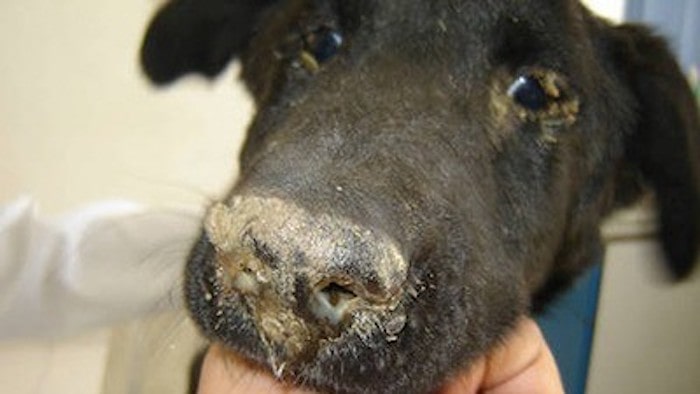As devoted dog owners, we cherish every wag of their tails and delight in their boundless energy. Our canine companions bring joy, love, and an unbreakable bond into our lives. However, amid all the playful antics and loyalty, there’s an unfortunate reality that every pet parent must face: the potential health risks that our furry friends may encounter.
One such threat, which looms in the shadows, is distemper in dogs – a highly contagious and often deadly disease. While it may not be a topic we like to dwell on, understanding the ins and outs of this silent threat is crucial to protecting the well-being of our beloved four-legged family members.
In this comprehensive guide, we embark on a journey through the world of distemper in dogs. We’ll explore its causes, symptoms, treatment options, and how we can work together to prevent its devastating impact on our canine companions.
So, let’s delve into the facts, dispel the myths, and equip ourselves with the knowledge needed to be proactive advocates for our furry friends. Together, we’ll face this silent threat head-on and ensure our dogs live long, vibrant lives filled with love and joy.
What is Distemper and How Does it Affect Dogs?
Distemper is caused by a paramyxovirus[1] that is closely related to the measles and rinderpest viruses. It is highly contagious and can spread through direct contact with an infected animal or object, through airborne exposure from coughing, sneezing, or barking, or through the placenta from a pregnant dog to her puppies.
Distemper can affect dogs of any age, but puppies are especially vulnerable because they have not developed their immune system fully.

Once a dog becomes infected with distemper, the virus initially replicates in the lymphatic tissue of the respiratory tract before moving on to infect other parts of the body. The incubation period of distemper is usually 3 to 6 days, but it can range from 1 to 4 weeks depending on the strain of the virus and the immune status of the dog.
“Some dogs that recover from CDV may have residual muscular twitches or seizures. Others may develop neurologic signs in the weeks following recovery or years later, in a syndrome called “old dog distemper” says, Dr. Aly Cohen, Cornell.
Distemper can cause a wide range of symptoms depending on the stage and severity of the infection. The symptoms can be divided into two stages:
Stage One
The first stage of distemper affects the respiratory and gastrointestinal systems. The symptoms may include:
- Watery to pus-like discharge from the eyes
- Fever
- Loss of appetite
- Clear nasal discharge
- Coughing
- Sneezing
- Depression
- Vomiting
- Diarrhea
Some dogs may only have mild signs or no signs at all in this stage. However, this does not mean that they are not contagious or that they will not develop more serious symptoms later.
Stage Two
The second stage of distemper affects the nervous system and other organs. The symptoms may include:
- Tremors
- Chewing motions of the jaw
- Seizures
- Partial or complete paralysis
- Pneumonia
- Crusting of the nose and foot pads
- Severe vomiting and diarrhea
- Death
The nervous system symptoms may appear at the same time as the respiratory and gastrointestinal symptoms or after a period of recovery. Some dogs may never develop nervous system symptoms, while others may have them as their only sign of distemper. The nervous system symptoms are often irreversible and can cause permanent damage or disability.
Symptoms and Diagnosis of Distemper in Dogs
The symptoms of distemper in dogs can vary widely and can mimic other diseases, such as kennel cough, parvovirus, rabies, or canine influenza. Therefore, it is important to consult a veterinarian if you notice any signs of illness in your dog, especially if he has not been vaccinated against distemper or has been in contact with an infected animal.
To diagnose distemper in dogs, a veterinarian will perform a physical examination and ask about your dog’s history and exposure. They may also run some tests to confirm the diagnosis and rule out other conditions. The tests may include:

- Blood tests to check for antibodies against distemper or changes in blood cell counts
- Urine tests to check for viral particles or signs of kidney damage
- X-rays to check for pneumonia or other lung problems
- Cerebrospinal fluid analysis to check for inflammation or infection in the brain or spinal cord
- Polymerase chain reaction (PCR) test to detect viral DNA in various samples
- Immunofluorescence test to detect viral antigens in various samples
The diagnosis of distemper in dogs can be challenging because some tests may not be available or reliable in all cases. For example, a negative antibody test does not rule out distemper if the dog has been recently infected or immunosuppressed.
A positive antibody test does not confirm distemper if the dog has been vaccinated or exposed to another paramyxovirus. A negative PCR test does not rule out distemper if the sample was taken too early or too late in the course of infection. A positive PCR test does not confirm distemper if there was contamination or cross-reaction with another virus.
Therefore, the diagnosis of distemper in dogs is usually based on a combination of clinical signs, history, exposure, and test results.
Treatment of Distemper in Dogs
Unfortunately, there is no cure for distemper and no specific treatment that can eliminate the virus from the body. The treatment of distemper is supportive and symptomatic, meaning that it aims to relieve the symptoms and prevent secondary infections or complications.
Ryan Llera, DVM, VCA Hospitals says, “The treatment for distemper is aimed at reducing the intensity of signs and symptoms.”

The common treatments for distemper include:
- Intravenous fluid therapy to prevent dehydration and electrolyte imbalance caused by vomiting and diarrhea
- Anti-vomiting medications to reduce nausea and vomiting
- Antibiotics to treat bacterial infections that may occur due to the weakened immune system
- Anticonvulsants to control seizures
- Painkillers to reduce pain and inflammation
- Immunomodulators to boost the immune system and fight the virus
The treatment of distemper can be costly and intensive, requiring frequent visits to the veterinarian and hospitalization. The outcome of the treatment depends on several factors, such as the age, health status, immune response, and strain of the virus of the dog. Some dogs may recover fully from distemper, while others may have permanent damage to their nervous system or other organs.
Early diagnosis and isolation of infected dogs are crucial to improve their chances of survival and prevent the spread of the disease. If you notice any signs of distemper in your dog, contact your veterinarian immediately and keep your dog away from other dogs until you get a diagnosis.
Prevention of Distemper in Dogs
The best way to prevent distemper in dogs is by vaccination[2]. Vaccination is a safe and effective way to protect your dog from distemper and other serious diseases. The distemper vaccine is one of the core vaccines for dogs, meaning that it is recommended for all dogs regardless of their lifestyle or exposure risk. The other core vaccines for dogs are parvovirus, canine adenovirus (hepatitis), and rabies.
The recommended vaccination schedule for puppies is:
- The first dose at 6 to 8 weeks of age
- The second dose at 10 to 12 weeks of age
- The third dose at 14 to 16 weeks of age
- A booster dose at 12 to 15 months of age

The recommended vaccination schedule for adult dogs is:
- A booster dose every 3 years or as advised by your veterinarian
The vaccination schedule may vary depending on the type of vaccine, the health status, and the risk factors of your dog. Consult your veterinarian for the best vaccination plan for your dog.
In addition to vaccination, you can also prevent distemper by:
- Keeping your dog away from sick or unvaccinated dogs and wildlife
- Cleaning and disinfecting your dog’s environment and supplies regularly
- Feeding your dog a balanced and nutritious diet
- Providing your dog with regular exercise and mental stimulation
- Taking your dog to the veterinarian for routine check-ups and health screenings
FAQs
Unfortunately, there is no specific cure for distemper. Treatment mainly focuses on supportive care to manage symptoms and boost the dog’s immune system. Vaccination is the most effective way to prevent distemper in the first place.
While vaccinations significantly reduce the risk, no vaccine is 100% foolproof. Some dogs may still be susceptible to the virus, especially if their immune system is compromised. However, vaccinated dogs usually have milder symptoms if infected.
Dogs that survive distemper may have lingering neurological effects or other health challenges. Recovery can be lengthy, and some dogs may require ongoing supportive care and monitoring.
Currently, there are no proven alternative treatments for distemper. Seeking prompt veterinary care and adhering to supportive care measures recommended by a veterinarian is essential for the best chance of recovery.
Conclusion
Distemper is a serious and potentially fatal disease that can affect dogs and other animals. It is caused by a paramyxovirus that spreads through direct contact, airborne exposure, or placenta. It causes a wide range of symptoms that affect multiple body systems, such as the respiratory, gastrointestinal, nervous system, and other organs. There is no cure for distemper and the treatment is supportive and symptomatic. The best way to prevent distemper is by vaccination and good hygiene.
If you want to protect your dog from distemper, make sure to follow the vaccination schedule recommended by your veterinarian and keep your dog away from sick or unvaccinated dogs and wildlife. If you notice any signs of distemper in your dog, contact your veterinarian immediately and isolate your dog until you get a diagnosis.
Distemper can be a devastating disease for dogs, but it can be prevented with proper care and attention. By vaccinating your dog and keeping him healthy and happy, you can give him the best chance to live a long and disease-free life.
Reference:
- Choi, E. Y., Ortega, V., & Aguilar, H. C. (2020, May 1). Feline Morbillivirus, a New Paramyxovirus Possibly Associated with Feline Kidney Disease. Viruses. Retrieved July 31, 2023. MDPI
- Tizard, I. R. (2021). Canine vaccines. In Elsevier eBooks (pp. 153-166.e1). NCBI

Ellis is a retired veterinary technician and full-time contributor at DogLovesBest. He likes writing about pet health care tips and reviews the products that are useful for fidos on a daily basis.
Ellis also guardians a Siberian husky, Nova, and a cat named Shilly. They all live happily with his wife Ammy, and both the dogs on a seaside apartment in Queens, NY.
